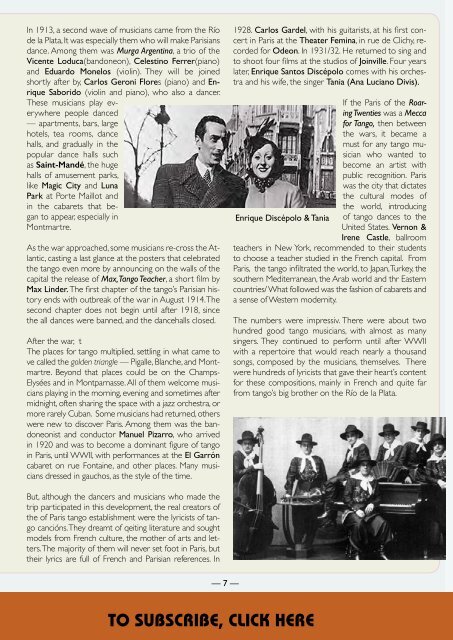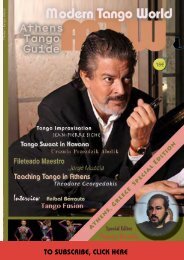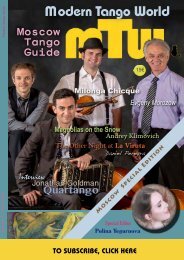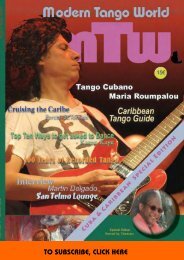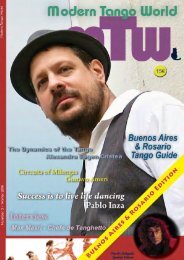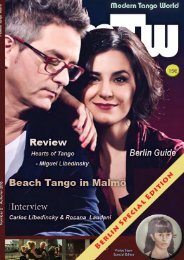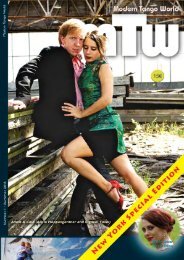Modern Tango World #11 (Paris, France)
Paris Special Features A Century of Parisien Tango Gwen-Haël Denigot 03 Alternative Tango in Paris Yannik Lhermitte 08 Outdoor Tango in Paris Emile Gayoso 13 Guide to Tango in France 18 Tango Portraiture Fabian Perez 28 Pablo Montanelli & Vito Venturino (El Cachivache) Ray Lauzzana 32 Dreaming of Buenos Aires in Moscow Anastasia Pomogaeva 35 Tango Beats in Ecuador Raymond Lauzzana 37 Tango Endings by Steve Darmo Alexandru Eugen Cristea 38 Our Advertisers 41 New Tango Music Arndt Büssing 42 Tango Moves: Boleo/Latigazo Raymond Lauzzana 44 Letters to the Editor 47
Paris Special Features
A Century of Parisien Tango Gwen-Haël Denigot 03
Alternative Tango in Paris Yannik Lhermitte 08
Outdoor Tango in Paris Emile Gayoso 13
Guide to Tango in France 18
Tango Portraiture Fabian Perez 28
Pablo Montanelli & Vito Venturino (El Cachivache) Ray Lauzzana 32
Dreaming of Buenos Aires in Moscow Anastasia Pomogaeva 35
Tango Beats in Ecuador Raymond Lauzzana 37
Tango Endings by Steve Darmo Alexandru Eugen Cristea 38
Our Advertisers 41
New Tango Music Arndt Büssing 42
Tango Moves: Boleo/Latigazo Raymond Lauzzana 44
Letters to the Editor 47
Create successful ePaper yourself
Turn your PDF publications into a flip-book with our unique Google optimized e-Paper software.
In 1913, a second wave of musicians came from the Río<br />
de la Plata, It was especially them who will make <strong>Paris</strong>ians<br />
dance. Among them was Murga Argentina, a trio of the<br />
Vicente Loduca(bandoneon), Celestino Ferrer(piano)<br />
and Eduardo Monelos (violin). They will be joined<br />
shortly after by, Carlos Geroni Flores (piano) and Enrique<br />
Saborido (violin and piano), who also a dancer.<br />
These musicians play everywhere<br />
people danced<br />
— apartments, bars, large<br />
hotels, tea rooms, dance<br />
halls, and gradually in the<br />
popular dance halls such<br />
as Saint-Mandé, the huge<br />
halls of amusement parks,<br />
like Magic City and Luna<br />
Park at Porte Maillot and<br />
in the cabarets that began<br />
to appear, especially in<br />
Montmartre.<br />
As the war approached, some musicians re-cross the Atlantic,<br />
casting a last glance at the posters that celebrated<br />
the tango even more by announcing on the walls of the<br />
capital the release of Max, <strong>Tango</strong> Teacher, a short film by<br />
Max Linder. The first chapter of the tango’s <strong>Paris</strong>ian history<br />
ends with outbreak of the war in August 1914. The<br />
second chapter does not begin until after 1918, since<br />
the all dances were banned, and the dancehalls closed.<br />
After the war, t<br />
The places for tango multiplied, settling in what came to<br />
ve called the golden triangle — Pigalle, Blanche, and Montmartre.<br />
Beyond that places could be on the Champs-<br />
Elysées and in Montparnasse. All of them welcome musicians<br />
playing in the morning, evening and sometimes after<br />
midnight, often sharing the space with a jazz orchestra, or<br />
more rarely Cuban. Some musicians had returned, others<br />
were new to discover <strong>Paris</strong>. Among them was the bandoneonist<br />
and conductor Manuel Pizarro, who arrived<br />
in 1920 and was to become a dominant figure of tango<br />
in <strong>Paris</strong>, until WWII, with performances at the El Garrón<br />
cabaret on rue Fontaine, and other places. Many musicians<br />
dressed in gauchos, as the style of the time.<br />
1928. Carlos Gardel, with his guitarists, at his first concert<br />
in <strong>Paris</strong> at the Theater Femina, in rue de Clichy, recorded<br />
for Odeon. In 1931/32. He returned to sing and<br />
to shoot four films at the studios of Joinville. Four years<br />
later, Enrique Santos Discépolo comes with his orchestra<br />
and his wife, the singer Tania (Ana Luciano Divis).<br />
If the <strong>Paris</strong> of the Roaring<br />
Twenties was a Mecca<br />
for <strong>Tango</strong>, then between<br />
the wars, it became a<br />
must for any tango musician<br />
who wanted to<br />
become an artist with<br />
public recognition. <strong>Paris</strong><br />
was the city that dictates<br />
the cultural modes of<br />
the world, introducing<br />
Enrique Discépolo & Tania of tango dances to the<br />
United States. Vernon &<br />
Irene Castle, ballroom<br />
teachers in New York, recommended to their students<br />
to choose a teacher studied in the French capital. From<br />
<strong>Paris</strong>, the tango infiltrated the world, to Japan, Turkey, the<br />
southern Mediterranean, the Arab world and thr Eastern<br />
countries/ What followed was the fashion of cabarets and<br />
a sense of Western modernity.<br />
The numbers were impressiv. There were about two<br />
hundred good tango musicians, with almost as many<br />
singers. They continued to perform until after WWII<br />
with a repertoire that would reach nearly a thousand<br />
songs, composed by the musicians, themselves. There<br />
were hundreds of lyricists that gave their heart’s content<br />
for these compositions, mainly in French and quite far<br />
from tango’s big brother on the Río de la Plata.<br />
But, although the dancers and musicians who made the<br />
trip participated in this development, the real creators of<br />
the of <strong>Paris</strong> tango establishment were the lyricists of tango<br />
cancións. They dreamt of qeiting literature and sought<br />
models from French culture, the mother of arts and letters.<br />
The majority of them will never set foot in <strong>Paris</strong>, but<br />
their lyrics are full of French and <strong>Paris</strong>ian references. In<br />
— 7 —<br />
TO SUBSCRIBE, CLICK HERE


